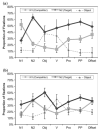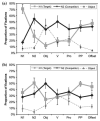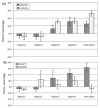Pronominal resolution and gap filling in agrammatic aphasia: evidence from eye movements
- PMID: 19370416
- PMCID: PMC2823636
- DOI: 10.1007/s10936-009-9105-7
Pronominal resolution and gap filling in agrammatic aphasia: evidence from eye movements
Abstract
This paper reports the results of three studies examining comprehension and real-time processing of pronominal (Experiment 1) and Wh-movement (Experiments 2 and 3) structures in agrammatic and unimpaired speakers using eyetracking. We asked the following questions: (a) Is off-line comprehension of these constructions impaired in agrammatic listeners?, (b) Do agrammatic, like unimpaired, listeners show eye movement patterns indicative of automatic pronominal reference resolution and/or gap-filling?, and (c) Do eyetracking patterns differ when sentences are correctly versus incorrectly interpreted, or do automatic processes prevail in spite of comprehension failure? Results showed that off-line comprehension of both pronoun and Wh-movement structures was impaired in our agrammatic cohort. However, the aphasic participants showed visual evidence of real-time reference resolution as they processed binding structures, including both pronouns and reflexives, as did our unimpaired control participants. Similarly, both the patients and the control participants showed patterns consistent with successful gap filling during processing of Wh-movement structures. For neither pronominal nor movement structures did we find evidence of delayed processing. Notably, these patterns were found for the aphasic participants even when they incorrectly interpreted target sentences, with the exception of object relative constructions. For incorrectly interpreted sentences, we found end of sentence lexical competition effects. These findings indicate that aberrant lexical integration, rather than representational deficits or generally slowed processing, may underlie agrammatic aphasic listener's comprehension failure.
Figures










Similar articles
-
Real-time comprehension of wh- movement in aphasia: evidence from eyetracking while listening.Brain Lang. 2007 Jan;100(1):1-22. doi: 10.1016/j.bandl.2006.06.004. Epub 2006 Jul 17. Brain Lang. 2007. PMID: 16844211 Free PMC article.
-
Understanding discourse-linked elements in aphasia: a threefold study in Russian.Neuropsychologia. 2014 May;57:20-8. doi: 10.1016/j.neuropsychologia.2014.02.017. Epub 2014 Mar 12. Neuropsychologia. 2014. PMID: 24631261
-
Binding in agrammatic aphasia: Processing to comprehension.Aphasiology. 2010 May 1;24(5):551-579. doi: 10.1080/02687030802634025. Aphasiology. 2010. PMID: 20535243 Free PMC article.
-
Automatic processing of wh- and NP-movement in agrammatic aphasia: Evidence from eyetracking.J Neurolinguistics. 2009 Nov 1;22(6):563-583. doi: 10.1016/j.jneuroling.2009.06.004. J Neurolinguistics. 2009. PMID: 20161014 Free PMC article.
-
Agrammatic comprehension of relative clauses.Brain Lang. 1989 Oct;37(3):480-99. doi: 10.1016/0093-934x(89)90031-x. Brain Lang. 1989. PMID: 2478254 Review.
Cited by
-
The time-course of lexical activation during sentence comprehension in people with aphasia.Am J Speech Lang Pathol. 2012 May;21(2):S179-89. doi: 10.1044/1058-0360(2012/11-0109). Epub 2012 Feb 21. Am J Speech Lang Pathol. 2012. PMID: 22355007 Free PMC article.
-
Verb Transitivity Bias Affects On-line Sentence Reading in People with Aphasia.Aphasiology. 2013 Mar 1;27(3):326-343. doi: 10.1080/02687038.2012.725243. Epub 2012 Nov 1. Aphasiology. 2013. PMID: 23554543 Free PMC article.
-
Effects of verb meaning on lexical integration in agrammatic aphasia: Evidence from eyetracking.J Neurolinguistics. 2013 Nov;26(6):619-636. doi: 10.1016/j.jneuroling.2013.04.002. J Neurolinguistics. 2013. PMID: 24092952 Free PMC article.
-
A rational inference approach to group and individual-level sentence comprehension performance in aphasia.Cortex. 2017 Jul;92:19-31. doi: 10.1016/j.cortex.2017.02.015. Epub 2017 Mar 15. Cortex. 2017. PMID: 28391038 Free PMC article.
-
The curious case of processing unaccusative verbs in aphasia.Aphasiology. 2017;31(10):1205-1225. doi: 10.1080/02687038.2016.1274873. Epub 2017 Jan 3. Aphasiology. 2017. PMID: 28989215 Free PMC article.
References
-
- Allopenna PD, Magnuson JS, Tanenhaus MK. Tracking the time course of spoken word recognition using eye movements: Evidence for continuous mapping models. Journal of memory and language. 1998;38:419–439.
-
- Altmann GTM, Kamide Y. Now you see it, now you don't: Mediating the mapping between language and the visual world. In: Henderson JM, Ferreira F, editors. The interface of language, vision, and action: Eye movements and the visual world. New York: Psychology Press; 2004. pp. 347–386.
-
- Avrutin S, Lubarsky S, Greene J. Comprehension of contrastive stress by Broca's aphasics. Brain and Language. 1999;70(2):163–186. - PubMed
-
- Berndt RS, Mitchum CC, Wayland S. Patterns of sentence comprehension in aphasia: A consideration of three hypotheses. Brain and Language. 1997;60:197–221. - PubMed
-
- Blumstein S, Byma G, Kurowski K, Hourihan J, Brown T, Hutchinson A. On-line processing of filler-gap constructions in aphasia. Brain and Language. 1998;61:149–168. - PubMed
Publication types
MeSH terms
Grants and funding
LinkOut - more resources
Full Text Sources
Medical
Miscellaneous

